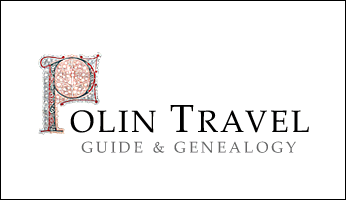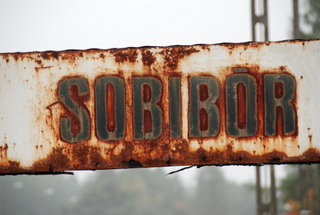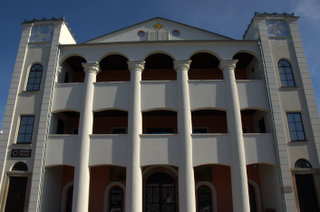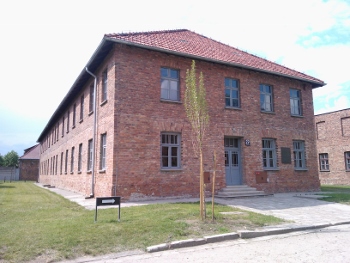News from Galicia
67th Anniversary of Auschwitz-Birkenau Liberation
In late January 1945 Auschwitz SS administration started the evacuation of 58 thousands of work capable prisoners into the III Reich interior, this initiated the infamous Auschwitz Death Marches. The hectic evacuation of the camp due to the fast approaching Soviet army was also encompassing the massive destruction of physical evidence of mass extermination project carried at the camp grounds from spring 1942 till late 1944. This included mass burning of camp records, removal of buried corpses and ashes, burning of Canada (prisoner's property) barracks. Finally on January 20th the SS blew up Crematoria, Gas Chamber number II and III and on January 26th the same was done with Crematoria, Gas Chamber number V. The similar building number IV was previously damaged and partly burned after the mutiny of Sondercommando prisoners on October 1944.
On the the 27th of January 1945 the Red Army troops entered the Auschwitz-Birkenau grounds liberating the entire large complex of camps with over 7000 emaciated prisoners still alive. This event gave an end to almost five years history of German Nazi Concentration and Extermination Camp Auschwitz-Birkenau which took lives of up to one and a half million of human beings, mainly Jews.
69 Anniversary of Sobibór Uprising
Pictures taken on October 4th,2012 of the least visited and commemorated of the Reinhard Action Death Camps where 250.000 to 300.000 Jews from Poland, Netherlands, Germany, Austria, Slovakia and Czech Republic and Jewish Soviet POW were killed from April 1942 till October 1943.
You can find the pictures at PolinTravel.Guide.Genealogy.Poland
Last year the first volume of Sobibór first monograph was published by Marek Bem in Włodawa.
This year in the 70 Anniversary of Wansee Conferance and Action Reinhard POLIN TRAVEL was making a photo documentation of all camps , ghettos and Nazi decision centers in former Nazi Lublin District. In case of anybody interested in photos we will be glad to share.
Sobibor Rail Sign October 2012
Dąbrowa Tarnowska Synagogue restored
In June 2012 the Synagogue in Dąbrowa Tarnowska was opened after major renovation works carried by the local municipality and financed from the city budget and EU funds. The restored building is housing the Center for the Meeting of Cultures in Dąbrowa Tarnowska with an extensive exhibit dedicated to the history of local Jewish community.
The Dąbrowa synagogue dates back to early 1860s when the growing Jewish community decided for this monumental structure along the main street in the city. It was build according to the plans of Jewish architect Abraham Goldstein. Funds were mostly provided by Izaak Stern, a local Jewish philanthropist whose donation was recognized in the Hebrew inscription in the upper part of the eastern wall. Construction and finishing works were conducted from 1855 to 1865. In early XX century a small synagogue for Orthodox Jews and Mikveh were build adjacent to the main building. During WW I the complex suffered some destruction because of the vicinity of the Russian-Austrian frontline and was restored with the donation of a local resident named Gold. Another, more extensive and throughout renovation was conducted from 1936 to 1937 under the supervision of Dora Mertz from Tarnów. A characteristic three-storey gallery flanked with two towers containing staircases was added at that time. Near the top of the towers there are four bas-relief sculptures of biblical animals with Hebrew inscriptions: be brave like a leopard, be light like as eagle, be strong like a lion, be nimble like a deer.
During WW II the synagogue was changed into warehouse by the German Nazis and in spite of some reconstruction attempts undertaken in the 1970s it had to wait as ruin until 2008 when the just finished major reconstruction was undertaken.
You can find the pictures at PolinTravel.Guide.Genealogy.Poland
Dąbrowa Tarnowska Synagogue October 2012
The New "Shoah" exhibition in block 27 in Auschwitz
On June 13th, 2013 the new exhibition in Auschwitz block 27 was inaugurated. The first exhibition in the so called ''Jewish pavilion or Jewish exhibition'' was opened in 1968, then it was refurbished and updated in 1978. The contemporary presentation titled Shoah is curated by Yad Vashem Institute and its director Avner Shalev in person. In his words the new exhibition shows 'Chapter by chapter, we show the most important topics related to the Holocaust, which is not necessarily a historical narrative, but rather a presentation of the very deep ethical and cultural dimensions of the memory of the Holocaust. To the visitor, this experience is to be a deep, meaningful and complete reflection on our fundamental morals as a people and members of today's global civilization.'
On the unveiling day the PM of Israel, Benjamin Netanyahu delivered a speech and officially inaugurated the exhibition. In his speech there was a personal accent 'I have just seen the children's drawings, flowers and gallows, and the drawing of a child who in a captivity draw a rabbit that runs around freely. I saw and touched the names of millions of Jews. Not all of them were sent here. One and a half million of them were murdered in the forests and the executions in the villages and in the pits. Among them was the twin sister of my blessed father-in-law Shmuel Ben Artzi. Hon Judith was beautiful and young. When she was murdered, she was about 20 years. I saw her name here. There are people who deny the Holocaust. Come to the block 27 and see the name after the name.'
The exhibition itself is taking two floors of block 27 in Auschwitz I. Although very modern display technology was used the whole project gives sense of simplicity and clarity. For the first time, in case of such presentations a large space is devoted to show Jewish life in Europe before the war. The films and pictures of Jewish life before 1939 are screened on walls around the visitor placing him into the middle of that rich civilization. This allows to gain the proper personal context and deepens the sense of loss caused by the genocide. Special value of those pre war images is realized in confrontation with the brutal reality of Auschwitz surrounding the building with exhibition. The narration doesn't limit itself to Auschwitz only but gives the general overview of Holocaust chronology including pre-war propaganda, ghettoization, execution sites and other death camps. Large part of the exhibition is devoted to children killed in the Holocaust and this topic is introduced and mediated by the simple drawings of children from Terezin covering the walls of one room. Every exhibit chapter is introduced with a short, basic description in English, Polish and Hebrew. The last room accommodates the pages with names of the Holocaust victims identified by Yad Vashem Institute through the testimonies of survivors, remaining documents and ongoing research. The building is also prepared for educational work with visiting groups offering special meeting places for ceremonies or reflection. There are some minor historical and language discrepancies, which surly will be corrected in the nearest future. The exhibition sets a new standard for Holocaust and genocide narration to the younger generations in the world especially in the times when the last survivors are slowly passing away. The Shoah in block 27 is highly recommended to every visitor of Auschwitz-Birkenau Museum who wants to understand more of the complexity of Holocaust and genocides.
You can find the pictures at PolinTravel.Guide.Genealogy.Poland
The New "Shoah" exhibition in block 27 in Auschwitz
7 MILESTONES FROM THE HISTORY OF POLISH JEWS, 7 DAYS BEFORE THE LONG AWAITED OPENING OF THE MUSEUM OF HISTORY OF POLISH JEWS IN WARSAW
In 2013 in Warsaw the impressive building of the Museum was inaugurated to start its long awaited service as an educational bridge gapping the void of Polish-Jewish relations non-existence. On October 28th , 2014 the eight core exhibition galleries were inaugurated to strengthen the museum's message and promote the heritage of Polish Jews and more complete understanding of ten centuries of their history.
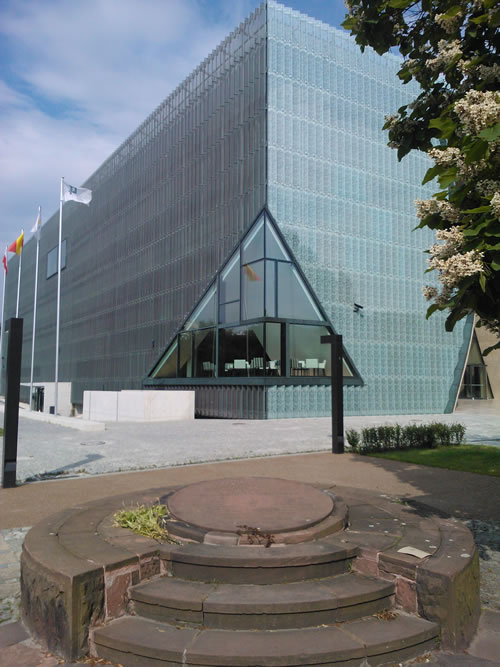
The Museum of history of Polish Jews in Warsaw - POLIN
Page 7 of 8
